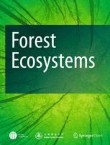Deposition of water-soluble inorganic ions in PM2.5 in a typical forestry system in Beijing, China
Rapid economic development in China has resulted in an increase in severe air pollution in city groups such as the Beijing–Tianjin–Hebei Metropolitan Region. PM2.5 (fine particles with an aerodynamic equivalent d...
